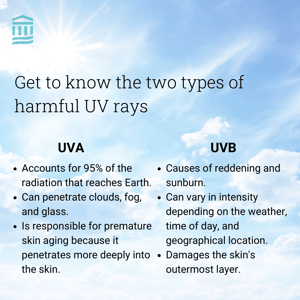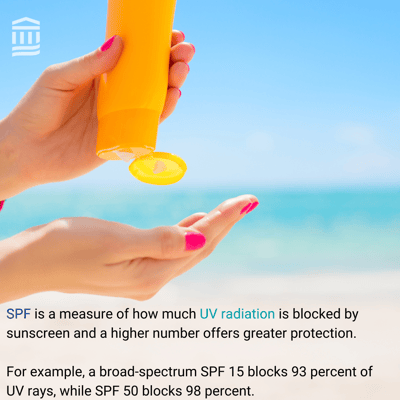Summer tips to shield yourself from sunburns
Sunshine offers major benefits when it comes to how the body processes vitamin D, but ultraviolet (UV) radiation from the sun also prompts concerns about skin damage and cancer risk, no matter what your skin tone. July has been declared UV Safety Awareness Month, to boost awareness and encourage more sun safety precautions.
Because UV radiation is the root cause of most skin cancers, the American Academy of Dermatology recommends three simple steps for more protection:
- Seeking shade when appropriate
- Wearing sun-protective clothing, such as long sleeves and hats
- Applying a broad-spectrum, water-resistant sunscreen with a sun protection factor (SPF) of 30 or higher
Shade and proper clothing are easy concepts to understand, but you might have questions about sunscreen. Is higher always better? And what does “broad-spectrum” mean? Here are some key facts about sunscreens to keep in mind when buying and applying:
SPF isn't about time

One common misconception is that the SPF number represents how long the product is protective; for example, SPF 30 would be safe for 30 minutes, but SPF 15 would be helpful for only 15 minutes. Another misconception is based on how long it takes you to get sunburned — so you might think that if you normally burn in an hour, then SPF 15 allows you to stay in the sun for 15 hours or 15 times longer without getting burned. But that’s not how it works.
SPF is actually a measure of how much UV radiation is blocked by the sunscreen, and a higher number offers greater protection, to a certain degree. For example, a broad-spectrum SPF 15 sunscreen blocks 93% of UV rays, while SPF 50 blocks 98%.
Skip the SPF 100
There are sunscreens that climb into the higher numbers, but the U.S. Food and Drug Administration (FDA) notes there isn’t evidence that protection above SPF 50 confers more benefits. Also, keep in mind that no sunscreen protects you completely.
Use broad-spectrum protection
There are two types of UV radiation, ultraviolet A (UVA) and ultraviolet B (UVB). The Skin Cancer Foundation notes that UVB rays are the type that produce sunburns, but UVA rays are responsible for skin aging, since they penetrate more deeply into the skin than UVB. Broad-spectrum sunscreen provides protection against both by creating a barrier that absorbs or reflects UV radiation before it can reach the skin and cause damage. Both types damage your skin’s DNA to the point that genetic mutations can occur and lead to skin cancer, which is why broad-spectrum protection is so important.
Apply 15 minutes before going outside
-1.png?width=300&height=300&name=LIZ%20Post%20Wrapped%20in%20Blog%20%20V%20(3)-1.png)
No matter what level of SPF you’re using, apply sunscreen 15 minutes before you go outside. This allows the product enough time to provide maximum benefit, according to the FDA. Use enough to cover your entire face and body, which means at least one ounce — about the amount that would fill a shot glass. Frequently forgotten spots include:
- Ears
- Tops of the feet
- Along the hairline
- Back of the neck
- Areas of the head exposed by balding or thinning hair
- Hands
Reapply every two hours, and more often if you’re swimming or exercising. Even if you’re just lounging outside, but it’s hot and humid enough to make you sweat, reapply more often.
All sunscreens wash off
.png?width=300&height=300&name=LIZ%20Post%20Wrapped%20in%20Blog%20%20V%20(2).png)
Sunscreens labeled as “water-resistant” are required to prove that claim to the FDA and must include directions on how often to reapply if you’re swimming or sweating. Most of these sunscreens remain effective for 40 to 80 minutes before reapplication is needed.
One important thing to know is that there’s no such thing as fully waterproof sunscreen, the FDA adds. Whatever you’re using will eventually wash off — there’s no sunscreen that you can apply once, then swim or play in the water indefinitely and still be protected.
Read the label
Sunscreens come in many forms, including lotions, creams, gels, sticks, and sprays. The FDA notes that how they’re applied can differ based on their form. For example, spray sunscreens should not be used on the face. The label will also provide information about the level of protection and suggested timeframe for reapplication.
Although July is UV Safety Awareness Month, taking time year-round to implement sun protection is essential. Choose the right sunscreen, make sure to stay out of the sun when UV rays are strongest — between 10 a.m. and 4 p.m. — and remember that UV radiation can go through clouds, so apply sunscreen even on cloudy days.
When it comes to sunshine, a little goes a long way. Take steps to make sure your skin is protected, no matter where the summer takes you.
You can find member resources at Mass General Dermatology

